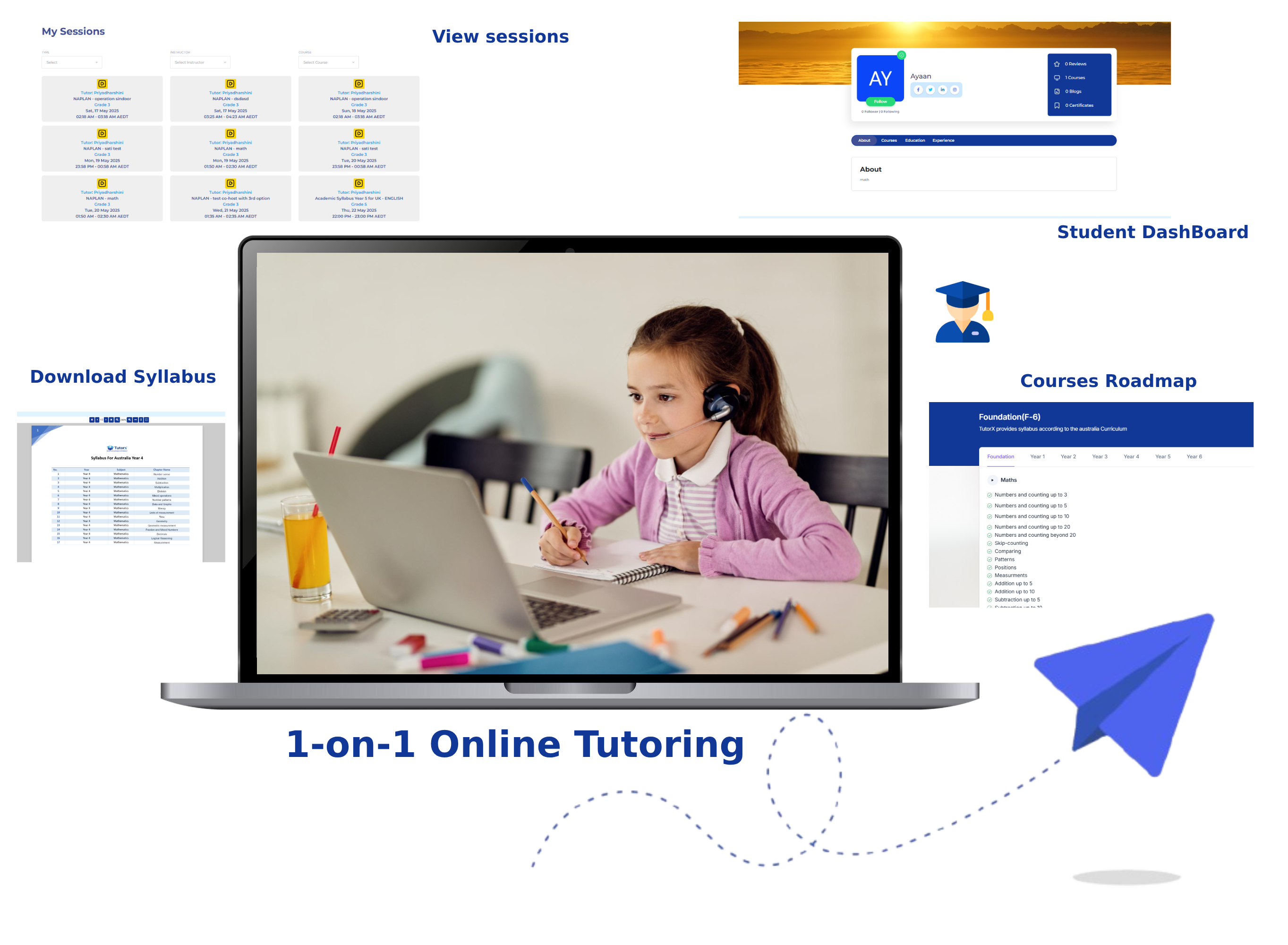Book a free trial session and start your personalized learning journey with our expert tutors.
Fill out the form below and one of our experts will contact you shortly.
Everything You Need, All in One Place
At The TutorX, we believe learning should be clear, focused, and at your fingertips. That’s why we’ve built a smart and user-friendly dashboard to empower every student on their academic journey. From live sessions and homework to performance tracking and resources—everything is seamlessly integrated to help you stay ahead with confidence.

The 11+ exam is a selective entrance test used by grammar schools and some independent schools to identify students with strong academic ability. It typically targets students in Year 6 and serves as a key part of the admissions process for secondary education. These exams are designed to assess a child's potential in core areas such as English, mathematics, verbal reasoning, and non-verbal reasoning. While the exact exam date can vary depending on the school or region, many tests are held in the early months of the year, often around January or February.

Children who wish to enter grammar schools usually sit the 11+ exam during the autumn term of Year 6. This academically selective test is designed to identify high-achieving students and may assess a mix of skills in English, mathematics, verbal reasoning, and non-verbal reasoning. The exact subjects covered depend on the school or local authority administering the test. Typically, the exam is paper-based, lasts about two hours, and includes multiple-choice questions. Known for its difficulty, the 11+ is intended to challenge students and highlight those performing at the top of their age group.
The content of the 11+ exam varies depending on the grammar school your child is applying to. Some schools are part of a consortium, where a single test is accepted by all member schools, while others have their own individual exams. If you're applying to multiple schools within the same consortium, your child will only need to sit one exam. However, applying to schools outside of that group may require separate 11+ tests for each school. The subjects covered in the 11+ can include English, Maths, Verbal Reasoning, and Non-Verbal Reasoning. English sections often focus on reading comprehension and SPaG (spelling, punctuation, and grammar), and some may also include a creative writing task. Maths questions are based on Key Stage 2 topics, although some exams may include Year 6 material that students haven't yet covered, testing how well they apply their knowledge to new problems. Verbal Reasoning and Non-Verbal Reasoning are not taught in the national curriculum, so children attending state primary schools may not have direct exposure to them in class. These reasoning sections assess a child’s cognitive ability—how well they recognise patterns, make logical connections, and solve abstract problems. Verbal Reasoning focuses on words and language, while Non-Verbal Reasoning involves working with shapes, patterns, and diagrams.
The number of questions in the 11+ exam depends on the exam board and the way each test is structured. For most students taking the GL Assessment version of the exam, there are typically two or three papers, and each one may cover a mix of different subjects. Common combinations include two papers—one testing English and Maths, and another testing Verbal Reasoning and Non-Verbal Reasoning. Alternatively, the test might combine English and Verbal Reasoning in one paper, and Maths and Non-Verbal Reasoning in another. In some cases, students might sit three separate papers—one each for English, Maths, and either Verbal or Non-Verbal Reasoning, or a blend of both. For full-length GL Assessment papers, the typical number of questions per subject is: English: 50 questions Maths: 50 questions Verbal Reasoning: 80 questions Non-Verbal Reasoning: 80 questions.
Each paper in the 11+ exam usually lasts between 45 to 60 minutes. This often includes a few minutes of unscored practice questions at the beginning, helping children get familiar with the format and reduce anxiety. In most cases, children take two or three papers on the same day, with a short break in between. However, some schools may choose to split the papers across different days, such as over two consecutive Saturdays.
| Question Type | Example Concepts |
|---|---|
| Maths | The four operations: addition, subtraction, multiplication, division ,Numbers and place value, Fractions, percentages, decimals, Algebra, Data and statistics, Ratio and proportion,Measurements, Shapes and space. |
| English | Encompasses Key Stage 2 objectives, including: Reading comprehension (based on unseen texts),Spelling and punctuation,Grammar (e.g., identifying word classes),Vocabulary (synonyms, antonyms, context clues),Sentence structure and rearrangement,Sometimes includes creative writing tasks |
| Verbal Reasoning | Assesses logic and language skills through:Word problems (e.g., hidden words, odd-one-out),Vocabulary and spelling patterns,Letter/number sequences and decoding,Logical deduction and following instructions |
| Non-Verbal Reasoning | Tests spatial awareness and logic through:Shape sequences,pattern recognition,Identifying nets, rotations, and reflectionsVisual puzzles and spatial problem-solving. |
Administrator

Lorem Ipsum is simply dummy text of the printing and typesetting industry. Lorem Ipsum has been the industry's standard dummy text ever since the 1500s, when an unknown printer took a galley of type and scrambled it to make a type specimen book.
Lorem Ipsum is simply dummy text of the printing and typesetting industry. Lorem Ipsum has been the industry's standard dummy text ever since the 1500s, when an unknown printer took a galley of type and scrambled it to make a type specimen book. It has survived not only five centuries, but also the leap into electronic typesetting, remaining essentially unchanged. It was popularised in the 1960s with the release of Letraset sheets containing Lorem Ipsum passages, and more recently with desktop publishing software like Aldus PageMaker including versions of Lorem Ipsum.
Reach out to TutorX your questions spark the path to smarter learning
